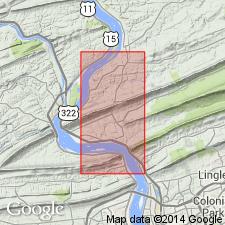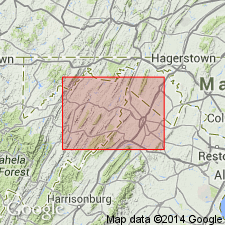
- Usage in publication:
-
- Mahantango formation
- Modifications:
-
- Named
- Dominant lithology:
-
- Shale
- Sandstone
- AAPG geologic province:
-
- Appalachian basin
Summary:
Named Mahantango formation for North Branch of Mahantango Creek, Snyder Co., PA. Unit is introduced to include all beds between Marcellus black shale and base of Portage. The formation is exposed throughout central PA except in a few sections in south-central Juniata Co. Thickness varies from a maximum of 1100 feet in Northumberland Co. to a minimum of 500 feet in western Juniata Co. With exception of the prominent Montebello sandstone, the formation throughout is of nearly uniform lithology. In south-central PA it contains coarse heavy sandstone lenses. The formation is chiefly uniformly dark gray or brown, usually clayey or finely arenaceous shale to fine-grained, dark, shaly sandstone that may become platy or flaggy locally. It is very fossiliferous and is divided in central PA into (ascending) Skaneateles, Ludlowville, and Moscow faunal facies. The Mahantango is of Middle Devonian age.
Source: GNU records (USGS DDS-6; Reston GNULEX).

- Usage in publication:
-
- Mahantango Formation
- Modifications:
-
- Overview
- AAPG geologic province:
-
- Appalachian basin
Summary:
Unit constitutes bulk of the Middle Devonian Hamilton Group in PA. Internal subdivision of the formation has been repeatedly revised. Stratigraphic relations between these lithostratigraphic members are uncertain. Figure 2 illustrates complex intertonguing of various members. In Bedford Co., south-central PA, formation has been subdivided into Gander Run Shale, Chaneysville Siltstone, Backbone Ridge Siltstone, Crooked Creek Shale, Donation Siltstone, Frame Shale, Clearville Siltstone, and Tully Members. Northeastward in Harrisburg, formation subdivided into Turkey Ridge, Dalmatia, Fisher Ridge, Montebello, Sherman Ridge, and Tully Members. In Stroudsburg, east-central PA, only the Centerfield Member is differentiated. Focus of this paper is on depositional cycles within Mahantango and formal member subdivisions of this unit are disregarded.
Source: GNU records (USGS DDS-6; Reston GNULEX).

- Usage in publication:
-
- Mahantango Formation*
- Modifications:
-
- Biostratigraphic dating
- AAPG geologic province:
-
- Appalachian basin
Summary:
Conodont biostratigraphy indicates that the Mahantango Formation in the Winchester 30 X 60 minute quadrangle is of Middle Devonian (Givetian) age. Conodonts indicative of the P. VARCUS and S. HERMANNI-P. CRISTATUS Zones were recovered from the Pokejoy Member.
Source: GNU records (USGS DDS-6; Reston GNULEX).
For more information, please contact Nancy Stamm, Geologic Names Committee Secretary.
Asterisk (*) indicates published by U.S. Geological Survey authors.
"No current usage" (†) implies that a name has been abandoned or has fallen into disuse. Former usage and, if known, replacement name given in parentheses ( ).
Slash (/) indicates name conflicts with nomenclatural guidelines (CSN, 1933; ACSN, 1961, 1970; NACSN, 1983, 2005, 2021). May be explained within brackets ([ ]).

